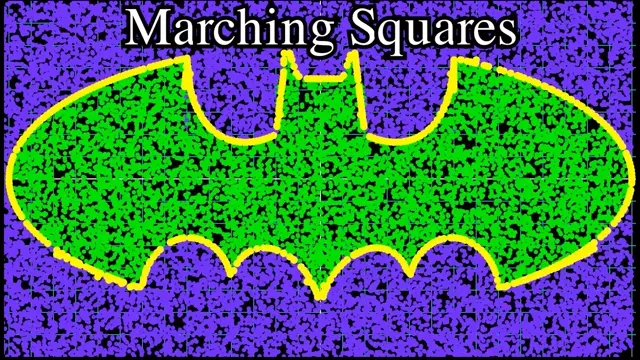2021-11-05
[public] 6.31K views, 13.8K likes, 7.00 dislikes audio only
In this video, we start with an interesting animation of blobby objects which we introduce as metaballs. There's a lot of surprisingly intricate ideas behind making these objects render on a screen. We'll see how folks in computer graphics attempted to solve this problem through a really elegant algorithm called marching squares. Marching squares is a really powerful algorithm that allows you to render any implicit function. But what's even more impressive in my opinion is the many clever shifts in perspective that allowed a vague problems such as this one to be transformed into a clear, well-defined, and solvable problem.
0:00 Introduction
3:29 Circles and Ellipses
4:57 Defining the Problem
6:00 A Guessing Game
8:29 Contours around Two Points
10:35 Sampling The Space
12:32 Breaking Down Cases
15:00 A Clever Optimization
17:20 How Marching Squares Works
18:59 Parallel Marching Squares
20:21 How Do Metaballs Work?
24:59 Marching Cubes
25:58 Some Parting Thoughts
References/Additional Resources:
http://jamie-wong.com/2014/08/19/metaballs-and-marching-squares/ - the initial inspiration for the framework of this video, great introduction to metaballs and how they can be rendered using marching squares.
http://www.geisswerks.com/ryan/BLOBS/blobs.html - great resource on implementing metaballs and some of the physics inspirations behind implicit functions
Original Marching cubes paper: https://www.researchgate.net/publication/202232897_Marching_Cubes_A_High_Resolution_3D_Surface_Construction_Algorithm
Sebastian Lague Video on Marching Cubes:
Further reading on polynomial approximations of metaball implicit functions:
https://www.researchgate.net/publication/242914163_Data_Structure_for_Soft_Objects
Implementation Help for Marching Cubes
http://paulbourke.net/geometry/implicitsurf/
Excellent lecture by Casey Muratori about Marching Cubes: https://www.youtube.com/watch?v=SDS5gLSiLg0&t=978s
https://courses.lumenlearning.com/physics/chapter/19-4-equipotential-lines/ - some of the physics behind equipotential lines in electric fields
Support: https://www.patreon.com/reducible
Twitter: https://twitter.com/Reducible20
This video wouldn't be possible without the open source library manim created by 3blue1brown and maintained by Manim Community.
The Manim Community Developers. (2021). Manim – Mathematical Animation Framework (Version v0.11.0) [Computer software]. https://www.manim.community/
Here is link to the repository that contains the code used to generate the animations in this video: https://github.com/nipunramk/Reducible
All music in the video is from Aakash Gandhi
/youtube/video/ajv46BSqcK4
/youtube/video/eED4bSkYCB8
/youtube/video/M3iI2l0ltbE
/youtube/video/6oMZb3yP_H8?t=0
/youtube/video/6oMZb3yP_H8?t=209
/youtube/video/6oMZb3yP_H8?t=297
/youtube/video/6oMZb3yP_H8?t=360
/youtube/video/6oMZb3yP_H8?t=509
/youtube/video/6oMZb3yP_H8?t=635
/youtube/video/6oMZb3yP_H8?t=752
/youtube/video/6oMZb3yP_H8?t=900
/youtube/video/6oMZb3yP_H8?t=1040
/youtube/video/6oMZb3yP_H8?t=1139
/youtube/video/6oMZb3yP_H8?t=1221
/youtube/video/6oMZb3yP_H8?t=1499
/youtube/video/6oMZb3yP_H8?t=1558
https://www.patreon.com/reducible
/youtube/video/yYEMxqreA10
/youtube/channel/UCK8XIGR5kRidIw2fWqwyHRA

